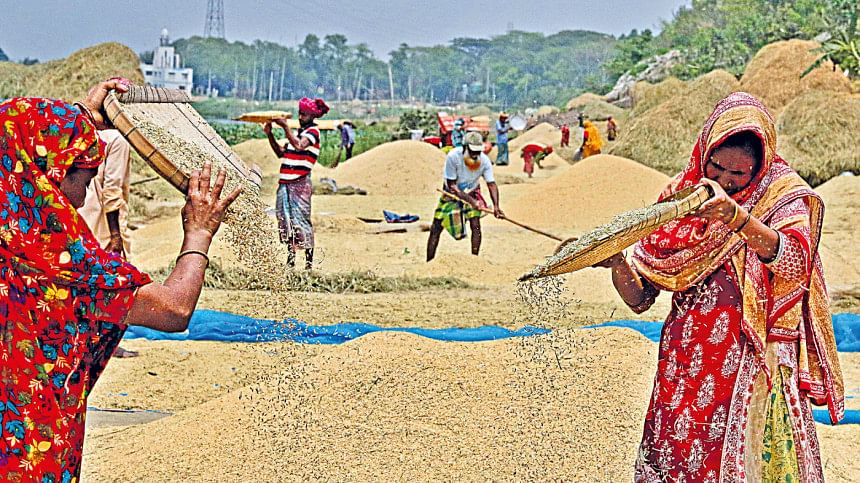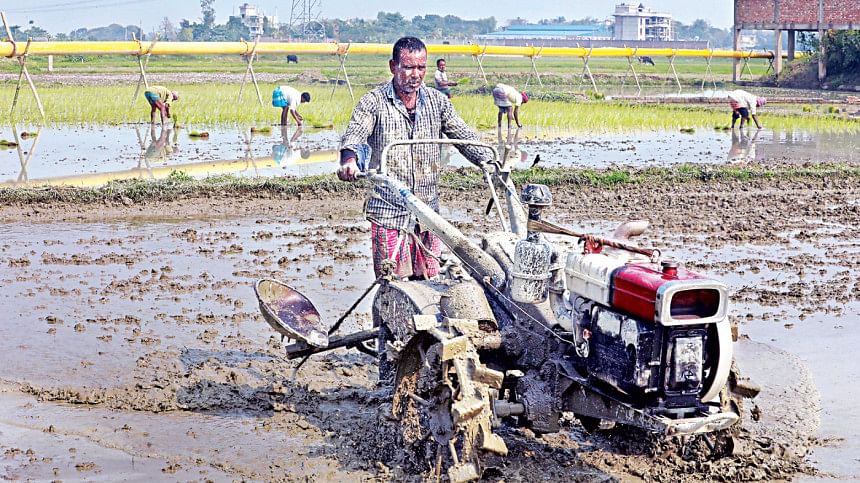Safeguarding food security

Bangladesh, despite its dense population and limited agricultural land, has successfully managed its food supply, largely due to the steadfast dedication and resilience of its farmers. Central bank policies, including initiatives such as agricultural loans, combined with proactive measures from state-owned and commercial banks, have played a pivotal role in providing crucial financial support for agricultural development. The increasing trend of loan disbursement in the agricultural sector holds promise for bolstering food security and fortifying the rural economy.
In FY24, the central bank has set a target of Tk 35,000 crore for agricultural and rural credit disbursement. This underscores the significance of ensuring adequate credit flow in the agricultural sector to stimulate GDP growth, boost agricultural production, and mitigate inflationary pressures arising from global factors.
Loan on easy terms
Traditionally, farmers have relied on borrowing money during specific agricultural seasons through two main channels: formal and informal. In rural areas, NGOs and high-interest moneylenders have been predominant options due to limitations within the established financial system. This often results in farmers falling into a debt trap, burdened with long-term loans.
According to the Agriculture and Rural Statistics Report of 2018, approximately 73.91% of households obtained loans from private sources, including NGOs, relatives, and moneylenders. Dr. Mizanul Haque Kazal, former dean of the Faculty of Agribusiness Management at Sher-e-Bangla Agricultural University (SAU), emphasized that farmers often end up with empty pockets after repaying these loans, perpetuating a cycle of debt that hinders their ability to improve their living standards and foster rural socioeconomic development.
"Due to the lack of institutional finance, farmers are unable to achieve the potential production of rice, resulting in income losses. Timely supply of credit at a low interest rate can significantly boost agricultural output," explained Md. Katebur Rahman, Senior Vice President and Head of the Agriculture Banking Unit at Dhaka Bank, which disbursed BDT 8,689.89 million among 94,000 farmers until March, 2024.
When banks disburse agricultural loans through their networks, farmers can access credit at a 9.13% interest rate. However, loans obtained through MFIs incur significantly higher interest rates, reaching up to 24%. "A 24% interest rate is exorbitant for farmers. Bangladesh Bank's decision to increase banks' disbursement targets by 50% underscores the cost-effectiveness of obtaining credit directly from banks. Our goal is to expand banks' reach even to the most remote areas of the country to meet farmers' needs," said Kamrul Mehedi, Head of SME, Micro Finance and Agent Banking at City Bank.
"Several agricultural sectors, including cropping and fisheries, rely on seasonal financing rather than year-round loans. Marginal and small-scale farmers often require seasonal loans. Timely loan disbursal is crucial for ensuring the efficiency of every stage in agro-processing. In addition to general microfinance, tailored loans and insurance can significantly impact the agricultural sector," emphasized Tausif Ahmed Qurashi, Senior Program Manager of the Climate Change Program at BRAC.
Enhancing agricultural production is crucial for ensuring the four components of food security: availability, accessibility, utilization, and stability. When farmers can profit from selling their produce, it boosts their purchasing power and contributes to overall food security.
MFIs obtain wholesale credits from banks to cater to lower-end borrowers. "Banks and MFIs significantly influence the rural economy by balancing the aspect of supply and demand, contributing to increased employment and purchasing power," highlighted Dr. Atiur Rahman, former Governor of Bangladesh Bank.
Improved productivity
Understanding production costs is crucial for farmers as it directly affects their profitability and long-term sustainability. By carefully analyzing production costs, farmers can make informed decisions about resource allocation, which, in turn, influences their agricultural operations and overall profitability.
According to Md. Belayet Hossan, Program Head of the Microfinance Program at BRAC, "The costs associated with fuel for machinery, fertilizers, pesticides, seeds, labor, and all other inputs have been steadily increasing every year. This year alone, the cost has surged by 5 to 10 percent per kilogram of rice."
BRAC's Microfinance Program supports approximately 600,000 farmers out of a total of 1.2 million beneficiaries.
Farmers are grappling with escalating production costs along with challenges such as natural calamities, resulting in reduced yields and subsequent income losses. "Typically, marginal farmers require funds for almost every crop cycle. Agricultural loans empower farmers by providing them with the financial resources needed to invest in seeds, fertilizers, machinery, and other inputs essential for crop cultivation. With access to credit, farmers can invest in quality inputs and timely cultivation practices, leading to improved productivity," said MD Nasiruzzaman, Chairman of Bangladesh Krishi Bank.
Ensuring accessibility of food
Enhancing agricultural production is crucial for ensuring the four components of food security: availability, accessibility, utilization, and stability. Dr. Mohammad Mizanul Haque emphasizes that when farmers can profit from selling their produce, it boosts their purchasing power and contributes to overall food security.
Surplus production enables farmers to engage in commercial activities, thereby increasing their purchasing power. "Marginal farmers, in particular, benefit from loans as they help boost productivity, especially when tailored to factors such as crop type and seasonal requirements. This is especially critical as the agricultural sector employs 51.88% of the total population," noted Dr. Mohammad Mizanul.
With increased production and supply, overall food security is strengthened. An adequate supply of agricultural produce supports employment opportunities, such as in shops and transportation, which are essential for agricultural processing and marketing. Dr. Atiur Rahman highlights that the efficient movement of agricultural products from farms to consumers is crucial for the sustainability of the rural economy.

Diversified food production
Crop diversification and cultivating alternate crops play a crucial role in bolstering food security by mitigating the risks associated with market fluctuations and crop failures. "In times of scarcity, especially with staples like rice and onions, which we often rely on imports for, securing our food supply necessitates robust domestic production," emphasized Dr. Atiur Rahman.
The central bank's policy of offering 4% interest for agricultural loans for alternative crops such as onions, pulses, oilseeds, spice crops, and maize cultivation has proven instrumental for Bangladesh. A Tk5,000 crore scheme has been implemented to ensure a consistent flow of loans to primary agricultural sectors at a low-interest rate.
This approach fosters stability in food prices, Rahman noted, underscoring the importance of diversifying food sources for greater security, not solely relying on rice production. Additionally, a Tk1,000 crore initiative aims to revive wheat and potato production. Diversifying agricultural activities enables farmers to mitigate risks associated with crop failure and market fluctuations, thereby enhancing food production and supply security.
Moreover, diversification enhances dietary diversity, ensuring access to a wider range of nutrients and promoting overall health and well-being in communities.
Promote mechanization
To promote mechanization in the agriculture sector, banks offer agro-machinery loans. "This scheme covers power tillers, reapers, rice transplanters, and combine harvesters, which cost millions to buy, making them unaffordable for small or marginal farmers. However, we provide agro-machinery loans to large agro-based companies such as Pran and ACI," explained Kamrul Mehedi of City Bank.
Dr. Mizanul proposes establishing groups of agricultural entrepreneurs at the upazila and thana levels, supported by loans or subsidies, to facilitate farmers' access to modern agricultural technologies such as combine harvesters during the irrigation period. This approach is poised to boost productivity, mitigate challenges faced by marginal farmers, and ultimately ensure food security.
"Farmers can be encouraged to use loans to invest in greenhouse technologies alongside modern farming equipment to increase efficiency and reduce production costs," said Dr. Atiur Rahman while emphasizing the adoption of green technologies such as solar irrigation pumping as a means of sustainable farming practices.
By carefully analyzing production costs, farmers can make informed decisions about resource allocation, which, in turn, influences their agricultural operations and overall profitability.
Despite the significant contribution of agricultural loans to food security, several challenges persist, including limited access to credit for smallholder farmers, high-interest rates, inadequate infrastructure, and limited financial literacy. "Many banks fail to fulfill their target in disbursing agricultural loans, which may cast a shadow on the country's efforts to boost food production," emphasized Prof. Mizanul.
Dr. Atiur Rahman highlights the significance of initiatives like BRAC's Tenant Farmers Development Project (BCUP), supported by a low-interest revolving fund from Bangladesh Bank. He believes that continuing projects similar to BCUP would be beneficial, recognizing Bangladesh's progress in the right direction. Rahman emphasizes the importance of coordinated efforts among policymakers, financial institutions, and other stakeholders to develop inclusive and sustainable agricultural financing mechanisms.

 For all latest news, follow The Daily Star's Google News channel.
For all latest news, follow The Daily Star's Google News channel. 







Comments